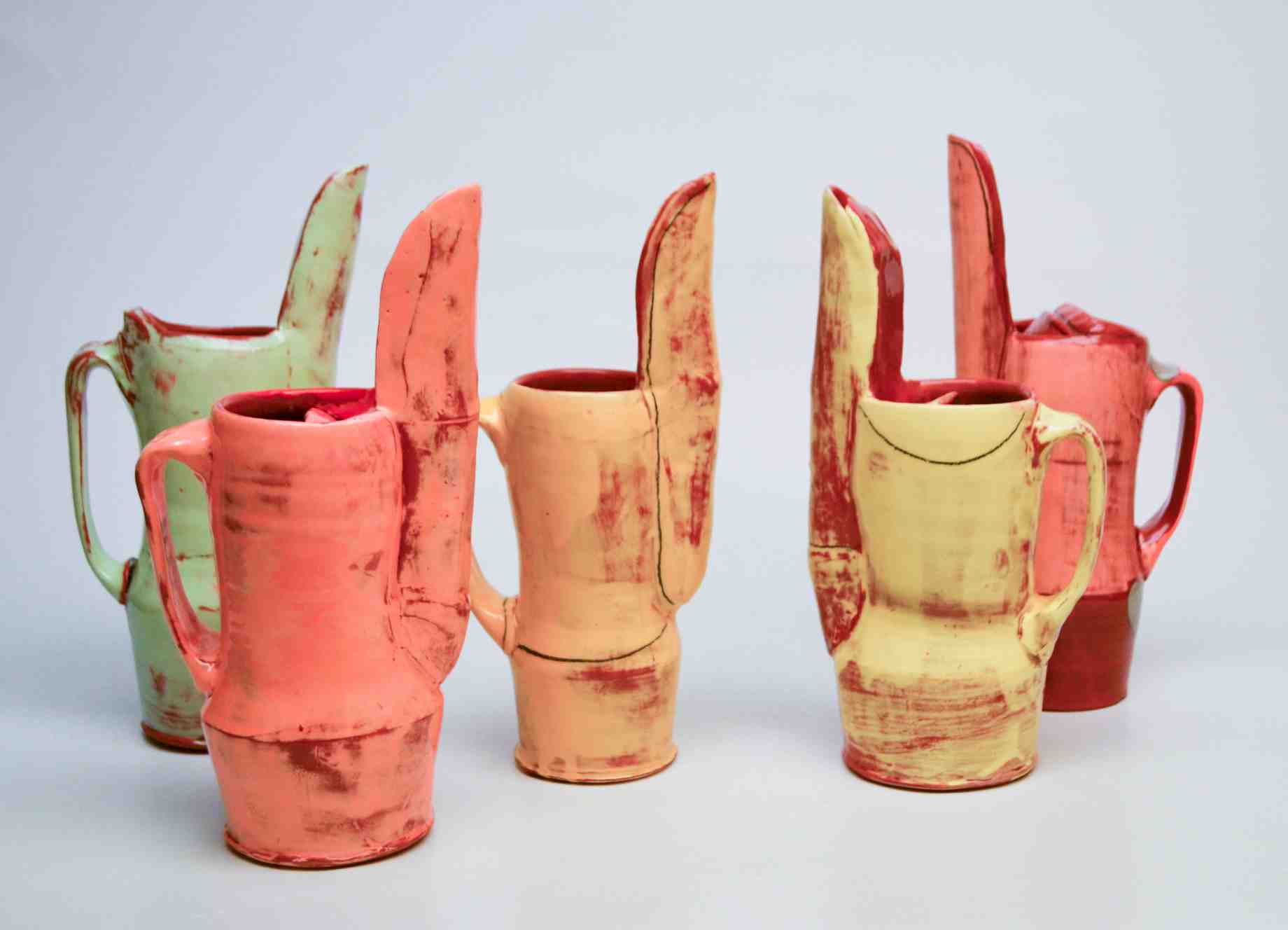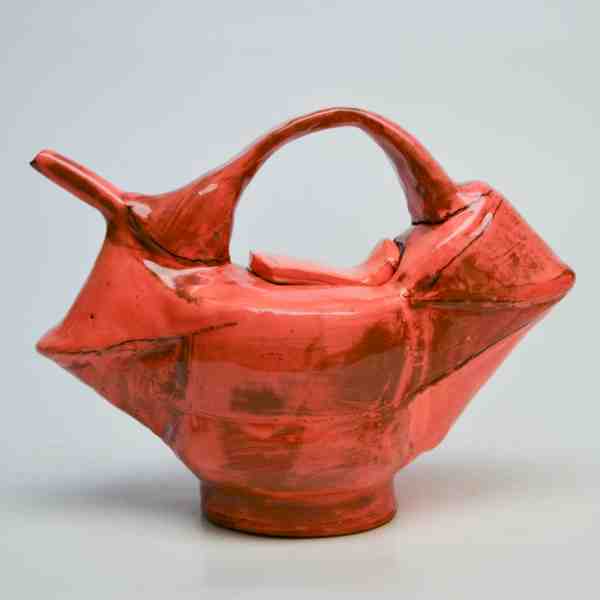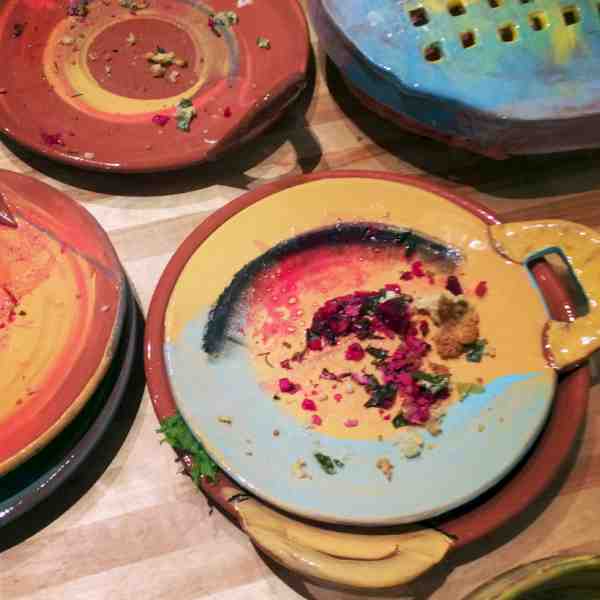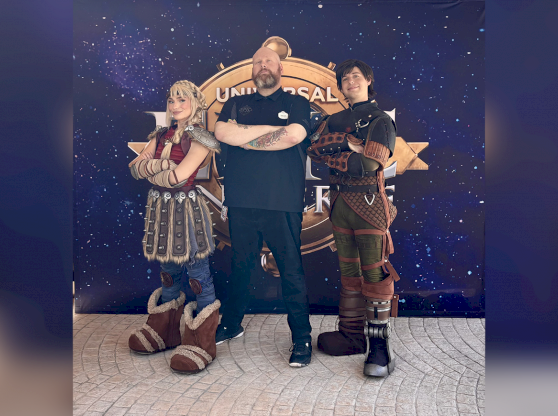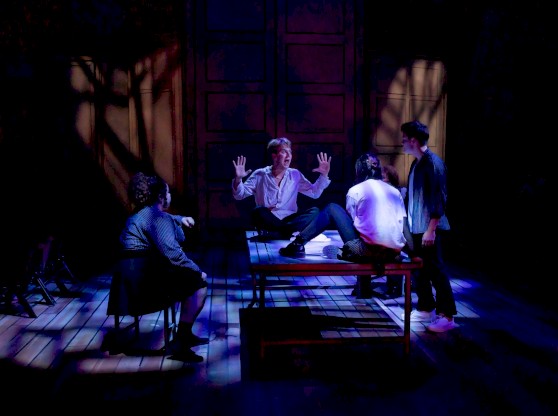In this interview, Adreena Cook, a third-year Printmaking MFA candidate, conducts an interview with Bridget Fairbank, a second-year Ceramics MFA candidate. Bridget discusses her art, activism and challenges the way we look at food.
Adreena: Describe your work in a couple of sentences. What is your “elevator speech”? What is the essence of your work?
Bridget: I make bright, functional, edgy earthenware pottery meant for the everyday. In doing so, I hope to challenge the norms of eating and engage in a modern ceramic discourse. I’d like to say there is a revolution cooking in my kitchen and kiln.
Adreena: How did you come into ceramics? What drew you in to the medium?
Bridget: I distinctly remember playing in the mud as a kid, then I somehow ended up in a night class as a young adult. I was driving to another town to take classes and had taken to having clay in my car. My friend, Matt, one day called me out on my newfound passion. I guess I had been talking a little too much about clay. He said, “Why don’t you suck it up and go to art school?” I had never truly considered that as a choice before. The rest is history. I was hooked.
Adreena: What drives you to make work?
Bridget: That is a really good question. The studio is my place of true autonomy and experimentation. I greatly enjoy making, but am also equally vexed and constantly failing. It is this combination of proficiency and challenge that keeps me making. I am trying to say something with clay and learning, still, its rarefied language.
Adreena: Do you see any similarities in your chosen medium and your interest in activism?
Bridget: Being a studio potter in itself is an act of activism. All potters are activists by simply being part of a counter culture. For me, this is no longer enough, and so I have begun searching and experimenting with ways that my pottery may directly engage with food politics. Food and ceramics have been connected since the first storage jar facilitated the dawn of agriculture. It is a medium that lends itself formally and historically to food.
Adreena: You mentioned in your studio that we live in a highly “self-curated” world; can you describe this concept a little further?
Bridget: In our global capitalized consumer culture, like never before has the individual had access to objects and unlimited styles. The large middle class has more than a modicum of disposable income, and has put social value in domestic space and personal style. So, people are looking around in a global manner and getting what they want, not necessarily what a class or region dictates. Consumerism has urged us to curate our private and public spaces distinctly and with vigor.
Adreena: How does our new ability to self-curate the world around us open up a dialogue for art-making and activism, and/or ceramics? Do any of these aspects inform your studio practice?
Bridget: Any variety of form, color, material and motif exists for our daily minutia and public/private spaces. These choices are considered personal expression where collected and displayed. This allows for subtle and broad daily commentary, expressed not through words but through objects. By paying attention to this and mobilizing the political ceramic object, we have a new way of communicating. I think about this constantly with the objects I make. I want to celebrate food, and foster a care in the production and consumption of food. Quite literally you are what you eat (the proteins that make the average American’s hair can be traced back in corn, the foundation of all processed foods). The modernist in me dares to say you are HOW you eat. We all must eat everyday.
Adreena: You mentioned the idea that is often discussed, wherein people feel at times that they must find ways to change pottery to keep it relevant. You stated that the opposite is the case, that we should alter the way that we look at the work or the way that we interact with it. How might we have to alter our looking-at-the-world or looking-at-pots, so that we do not question their relevancy?
Bridget: Handcrafted pottery is entirely relevant, even if in a niche market and as a small discourse. Right now, I think the diversity of work being made is a testament to that. The ceramic field encompasses sculpture, pottery, digital technologies, social engaged practices, performance, ephemeral work and installation. I commented that physical access to using well-made functional pottery is rare, and that for those items to be experienced, the 1:1 ratio of use that most objects are subjected to, should or could be changed. Perhaps pots can be activated in new ways by re-thinking the spaces around them, rather than changing the form or medium itself. Outreach work is greatly needed in the tight-knit ceramics community.
Adreena: Can you briefly talk about the craft revolution that you mentioned and your interest in it? Is the rebellion you are a part of against objects that are function, not enriching, like a plain, old plastic travel cup? Please talk for a moment about the draw or appeal of handcrafted goods.
Bridget: Without seeming impractical, I do think the human touch is important. All of our objects are connected to people though we don’t pay attention to that. Our object should have emotional value. Imagine a world where every piece of trash you created you saw in terms of sweat equity of a close friend. What would that do to our landfills? Objects should be enriching and critically imbue the day to day with meaning. We are disconnected from means of production and materials. Handcrafted objects bridge this gap, and the DIY movement and urban back-to-the-land revival exemplify that. We are beginning to value the local handmade, rarified, unique object in a very contemporary way.
Adreena: Your work almost seems to ask the question, “How does change happen?” With your interest in activism, can you speak a little bit about how you feel change can happen in relation to your medium, and in relation to a food revolution? Do you see any similarities between the two?
Bridget: Food is not food and a plate does not simply hold salad. The salad is a local food movement and the handcrafted pot is a cultural statement. This work questions the pot as personal expression, the pot for food and the pot as the impetus for change. The work is not about the ergonomics of use but about the presence of humanity, messy and impulsive, a manifestation of choices in making. Eons of eating are at the core of these objects. The act of eating is vital to the object’s existence. They must create space and time to acknowledge and question our actions. I wonder, can pots alter the consciousness and eating actions of users by facilitating the enjoyment of food? Through ceramics can we foster an interest in sustainable, happy and healthy eating and living? Through emotional investment in the act of eating, can an audience change our current destructive and fatal food systems? This is what I hope to discover. Humans are creatures of comfort, pleasure seeking beings and so a frequently displayed or used pot must give us pleasure, must foster joy. My work is comfortable and uncomfortable. It beckons for use, while subtle formal considerations alter one’s actions.
These pots ask us to eat together and celebrate the culture of food. In this celebration and sharing, I hope that more complex ideas of food can be observed and discussed. The pots create space at the table.
Adreena: Your work alteration, places of transition, volume from inside/outside and constraint; do any of these aspects symbolize an idea or concept for you? When you work on a piece and incorporate these aspects, are you thinking about something specific?
Bridget: I think they all do. I had never considered it in literal terms quite like that. The way I form talks about flexibility and constant reactionary alteration until a balanced, active and engaging form is found. I urge us in our eating habits, and consider each bite a daily, monetary vote to foster change and find better healthier long term solutions. The construction of my pots shows adaptive change in color and construction.
Adreena: What are the greatest strengths and pitfalls of working in the field today?
Bridget: The ceramic field is dynamic and active. The variety of work is astounding. A great pitfall is that it is very hard to make a living; the market is simply small, though growing. Ceramists are not free to work in the studio in ways that may often fail- an important aspect of research and progress. It is a stressful and hard living. This means that the people working in clay are dedicated and very skilled, but success is skewed when measured in terms outside of the ceramics community. There is a lack of academic peer reviewed writing from critics and art historians because, in their fields, there is no infrastructure to support them. This means that the field is stunted, financially and academically, unless viewed from an anthropological or technical view point. This also means there is an exciting need for supported artistic research and great opportunity. We refer to the field as a “community” because ceramists have had to band together for survival. With this community comes collaboration, teamwork and ingenuity which can be seen surveying the field today.
Adreena: Do you work in series? Why? Please explain your process a little.
Bridget: My process lends itself to making in series. I form many pieces at once and fire them together, filling the kiln. I then add more color clay and fire again, then glaze and a final firing. I like to work in series and on many pieces at once. It is a dynamic way to work through ideas and make comparisons. The workmanship of risk allows me to constantly change and test pieces.
Adreena: What are you most excited about in this work?
Bridget: Then endless possibility of communication in form and color. I am excited about making awkward/elegant forms for food that make for good table conversation. I am also excited about taking the dinner table out into the public, and conceiving of new places for pottery activation.
Adreena: What are you most excited about for the future?
Bridget: I am excited about getting people together over pots and food, to generate new ideas and situations for our lives and communities. It is time to get pots in peoples' hands and foster a food revolution.
